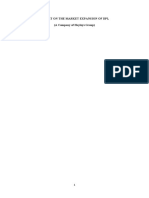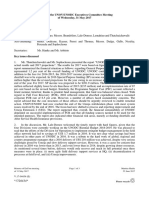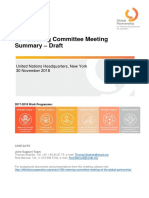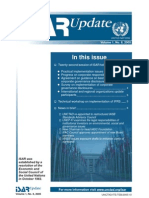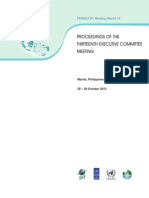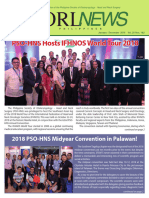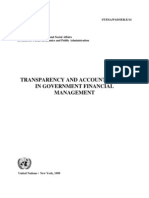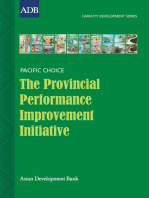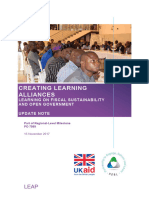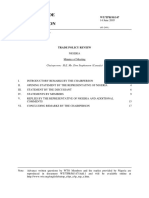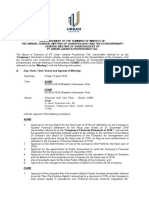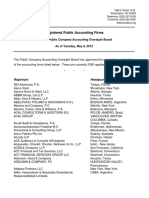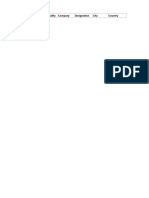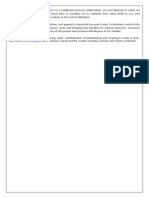Minutes of Meeting
Minutes of Meeting
Uploaded by
Dexie Cabañelez ManahanCopyright:
Available Formats
Minutes of Meeting
Minutes of Meeting
Uploaded by
Dexie Cabañelez ManahanOriginal Description:
Copyright
Available Formats
Share this document
Did you find this document useful?
Is this content inappropriate?
Copyright:
Available Formats
Minutes of Meeting
Minutes of Meeting
Uploaded by
Dexie Cabañelez ManahanCopyright:
Available Formats
Annual Meeting
INTOSAI Working Group on Public Debt
Manila, Philippines
September 27-29, 2017
Minutes of Meeting
The 2017 Annual Meeting of the INTOSAI Working Group on Public Debt (WGPD) was held
in Manila, Philippines on September 27 to 29, 2017. The Meeting was presided over by the
new WGPD Chairperson, Atty. Michael G. Aguinaldo, Chairperson of the Commission on
Audit (COA), SAI Philippines and was facilitated by Ms. Melanie R. Añonuevo, Chairperson
of the WGPD Secretariat.
I. Welcome/Opening Address
By: Atty. Michael G. Aguinaldo, WGPD Chairperson
Opening Remarks
The new WGPD Chair, Atty. Michael G. Aguinaldo, greeted and welcomed in his
speech the speakers of the event and all the participating delegates.
Highlights
Chair Aguinaldo discussed the history of public debt both in the international scene
and the local setting, gave a brief overview of the Philippines’ public debt status and
what audits SAI Philippines has conducted related to public debt.
Closing Remarks
In closing, Chair Aguinaldo hoped for a fruitful, meaningful, and relaxed discussion
with the attending delegates. He once again welcomed them to the Meeting and
thanked them for listening.
II. Keynote Speech
By: Atty. Erwin D. Sta. Ana, Deputy Treasurer of the Philippines
Opening Remarks
Atty. Sta. Ana extended his gratitude to the Commission on Audit, on behalf of the
Philippines National Treasurer Rosalia de Leon, for inviting him to discuss public debt
and public debt management with the INTOSAI Working Group. He hoped that his
discussion would shed light on the topic and provide key information for the Working
Group.
Highlights
Atty. Sta. Ana discussed in detail the Philippines’ current debt situation and how the
national government manages its debt. He presented several metrics to characterize
the Philippines’ debt profile, which showed that the country is in a sound fiscal
position reflective of years of continuous progress. The favorable debt metrics have
led to an improving credit profile and landmark transactions that, in turn, have also
led to innovative sources of financing. To maintain this debt position, the national
government is working on managing key risks, such as foreign exchange risk,
interest rate risk, and refinancing risk.
Minutes of the 2017 WGPD Annual Meeting | Page 1 of 21
Annual Meeting
INTOSAI Working Group on Public Debt
Manila, Philippines
September 27-29, 2017
Closing Remarks
Atty. Sta. Ana stated that, in summary, the debt metrics of the Philippine national
government are in the best shape yet, and that the national government shall
continue on working on key initiatives to ensure debt sustainability in the long term.
III. WGPD Chair’s Report
By: Atty. Michael G. Aguinaldo, WGPD Chairperson
Opening Remarks
Chair Aguinaldo opened his report by stating that 2017 is a unique point in time for all
WGPD members as the group endeavors to perform its mandate under a new
leadership, guided by fresh strategies, and inspired by renewed commitments.
Highlights
The key points discussed in the WGPD Chair’s Report were:
a. The handover of chairmanship from SAI Mexico to SAI Philippines, in which both
parties engaged in cooperative means of exchange that include email
exchanges, handover of WGPD documents, and videoconferences;
b. Actions and status to implement the WGPD strategies and initiatives in
conformity with the requirements of Knowledge Sharing Committee and for
purposes of reporting to the INTOSAI Governing Board in November;
c. Revision of ISSAIs and recent developments that will affect its completion; and
d. The identification of the SAI to host the next in-person meetings.
Closing Remarks
To end his report, Chair Aguinaldo said that the WGPD will strive to contribute to the
implementation and eventual success of the KSC strategic objectives and/or priorities
that are aligned with the Strategic Plan 2017-2022 of the INTOSAI.
IV. Endorsement of the Agenda of the Meeting
By: Ms. Melanie R. Añonuevo, SAI Philippines
Opening Remarks
Ms. Añonuevo directed everyone’s attention to the “Yes/No” placards given to each
delegate as a means to vote on some issues that the body will need to decide on.
She then acknowledged the 16 represented SAIs in the Meeting out of the 27
members, namely Austria, Azerbaijan, Brazil, China, Fiji, Georgia, India, Indonesia,
Jordan, Kenya, Korea, Portugal, Romania, the Russian Federation, the United
States, Zambia, and the Philippines as the host SAI. Excluding 13 delegates from
SAI Philippines, a total of 24 delegates attended the Meeting.
Ms. Añonuevo expressed her gratefulness to the guest Resource Speakers including
the INTOSAI Development Initiative (IDI) Deputy Director General Ms. Archana
Shirsat, who was joined by Mr. Marcelo Tricarico, an IDI expert; the representative
from the Forum for INTOSAI Professional Pronouncements (FIPP), Mr. Novy
Minutes of the 2017 WGPD Annual Meeting | Page 2 of 21
Annual Meeting
INTOSAI Working Group on Public Debt
Manila, Philippines
September 27-29, 2017
Pelenkahu; and the representative from World Bank, Ms. Signe Zeikate. She also
acknowledged the representatives from SAI Philippines, which consist of Assistant
Commissioners, Directors, Supervising Auditors, and Senior Auditors, who form the
Technical Working Group of the WGPD.
Discussions/Agreements
Mr. Pelenkahu requested that his presentation on the SDP Implementation
and revised Due Process be moved to the afternoon of Day 1 of the Meeting.
Ms. Cora Lea dela Cruz suggested that the presentation of Mr. Pelenkahu
may be done before the presentation of SAI Philippines on Project 2.9 on Day
1, which the body agreed to.
Closing Remarks
There being no other matters to discuss regarding the agenda and the order of the
presentations, Ms. Añonuevo moved to start the first presentation on administrative
matters.
V. Administrative Matters
By: Ms. Melanie R. Añonuevo, SAI Philippines
Opening Remarks
To signal the start of the meeting proper, Ms. Añonuevo shared with the attending
delegates’ information on the following administrative matters:
Updating of database of Experts in Public Debt Auditing;
Status on the updating and revisions of the Handbook for WGPD Meetings to
include processes (e.g. Handover of Chairmanship, WGPD Organizational
Structure with proposed creation of the Vice-chair position); and
WGPD Organizational Structure.
Discussions/Agreements
As a result of calls for the updating, a total of 40 experts are now listed in the
database from the names sent by 20 SAI-members.
Six SAIs, on the other hand, have not yet provided update on their respective
line-up of experts. SAIs Egypt, India and Yemen are yet to update the names
of their experts while SAIs Gabon, Kenya and Romania are yet to provide the
names of their experts.
It is important to settle and arrive at the total number of experts as these
experts will play vital role in providing technical expertise and relevant
experiences in the fulfillment of the existing and future projects of the Working
Group.
On the status of revisions of the WGPD Terms of Reference (TOR) and
Handbook, only some of the comments were presented in this session of the
meeting; the rest of the comments received were discussed in a separate
session of the meeting, where appropriate.
Minutes of the 2017 WGPD Annual Meeting | Page 3 of 21
Annual Meeting
INTOSAI Working Group on Public Debt
Manila, Philippines
September 27-29, 2017
The advent of a new leadership in the WGPD had opened its doors for
changes, which include its organizational structure. One proposed change is
to establish a Vice-Chair position. The Vice-Chair is envisioned to act as the
Chair’s representative in any event and/or occasion in case the latter is
unavailable. The detailed functions of a Vice-Chair are incorporated in the
revised version of the TOR.
Closing Remarks
Ms. Añonuevo opened the floor for questions, but none was asked whatsoever.
VI. WGPD Strategic Plan 2017-2022
By: Ms. Dawn B. Simpson, SAI USA
1. Background and status
2. Proposed revisions
3. Agreements reached based on the proposed revisions
Opening Remarks
The revision of the Strategic Plan (SP) is an important activity for the WGPD
considering the members extended the validity of the SP 2007-2012 until 2016, so
that the next SP could be aligned to the INTOSAI’s Strategic Plan 2017-2022. The
guidance materials on the revision of the SP, which was drafted by SAI Mexico, was
disseminated to all members of the task team identified initially at the Nanjing, China
Meeting, composed of SAIs Russian Federation, Moldova, USA, and the IDI.
Comments from SAIs USA, Russia, and the Philippines were received.
Highlights of Presentation
The presentation discussed the comments provided by the individual task team
members on the objectives, mission, vision, goals, and strategies. Overall, the
revisions proposed by the comments were similar in nature.
Agreements
The IDI acknowledged the alignment of the working group’s Strategic Plan with the
INTOSAI’s Strategic Plan for 2017-2022, as well as considering the capacity
development as one of the working group’s objectives.
It was also noted that the IDI is specifically interested in monitoring and getting
feedback on how guidance related to the audit of public debt are being utilized by the
SAIs in the INTOSAI community.
As to the use of the term ‘Standards’ and ‘ISSAIs’ in the Strategic Plan, it is
suggested that since the working group is going to implement new IFPP, it is better to
use ‘Guidance’ instead.
Minutes of the 2017 WGPD Annual Meeting | Page 4 of 21
Annual Meeting
INTOSAI Working Group on Public Debt
Manila, Philippines
September 27-29, 2017
The Task Team in the revision of the Strategic Plan shall be composed of the
following SAIs:
1. Philippines (Task Team Leader)
2. Georgia
3. Russian Federation
4. United States of America
5. Moldova (to be confirmed)
Closing Remarks
The presentation focused on the comments of members (SAIs Russian Federation,
USA, and Philippines). The guidance materials and the consolidated comments
were also disseminated to all members prior to the meeting for further comments.
The draft Strategic Plan 2017-2022 shall be disseminated to the Task Team for
comments due on 20 October 2017 while the consolidated comment/s and final draft
shall be submitted to the WGPD Chair on 15 November 2017.
VII. WGPD Work Plan 2017-2019
By: Ms. Ma. Theresa B. Ferreros, SAI Philippines
1. Background and status
2. WGPD projects and activities
3. Proposed revisions
4. Agreements reached based on the proposed revisions
Opening Statement
In response to a request made by the Chair of the Knowledge Sharing and
Knowledge Services Committee (INTOSAI Goal 3, KSC), the WGPD Work Plan
2017-2019 was jointly prepared by SAI Mexico and SAI Philippines, in their positions
as former and incumbent Chair, respectively. The Work Plan may be modified
considering the perspectives from SAI Philippines, the feedback from both the KSC
Chair and FIPP, comments from the WGPD members and IDI, as well as new
developments on public debt auditing.
The draft Work Plan was disseminated to all members in July 2017 for comments
and suggestions. Based on the comments gathered, SAI Philippines drafted the
revised Work Plan 2017-2019 which was also circulated to all members for further
comments.
Highlights of Presentation
The presentation focused on the following:
1. Present activities in the draft Work Plan 2017-2019 which were commented
on by the SAI members;
Minutes of the 2017 WGPD Annual Meeting | Page 5 of 21
Annual Meeting
INTOSAI Working Group on Public Debt
Manila, Philippines
September 27-29, 2017
2. Present activities in the draft Work Plan, which were revised and proposed for
deferment:
o Guidance material for public debt auditors on debt authorization and
debt contracting;
o Guideline on Public Debt Management Office; and
o Inclusion in the Working Group’s activities of the participation to Project
2.5 (Consolidated and improved guidance on understanding internal
control) under the Strategic Development Plan for the IFPP 2017-2019.
3. Activities to be defined in alignment with the Key Strategies identified in the
working group’s Strategic Plan;
4. Proposed Work Plan format outline; and
5. Proposed revision of the tabular format and content of the Work Plan.
Agreements
It was noted that the SAI of the Russian Federation considers the work of the revision
of the standards to be the most important work.
On the other hand, the IDI expressed its interest in the performance measurement
framework being proposed by the Working Group in measuring its outputs. In
considering performance measurement, one of IDI’s suggestions is to focus not only
on outputs but also expected outcomes.
Also, since the work plan and the strategic plan of the WGPD are aligned with the
INTOSAI’s, the IDI opens the idea of the WGPD engaging in activities to contribute in
the implementation of Sustainable Development Goals (SDGs). Contributing to the
accomplishment of SDGs is one of the cross-cutting priorities under the INTOSAI
Strategic Plan 2017-2022.
The SAI of Kenya believes that a call for interest in developing the guideline in the
audit of the government guarantee was communicated during the presentation based
on the comment of the SAI of the Russian Federation on the updating of the
Guideline on “Auditing Public Debt Management”, where the latter acknowledged the
importance of the audit of the government guarantees in the area of public debt and
had noted that it is quite useful to note if there are interested SAIs in a more detailed
work on the audit of government guarantees. Moreover, SAI Kenya expressed its
interest in joining the task force that would be working on this in the future.
Closing Remarks
Hearing no objection, the WGPD Chair requested the group to approve the revised
Work Plan which is still subject to further discussion on some of the items that were
brought up such as the SDGs.
Minutes of the 2017 WGPD Annual Meeting | Page 6 of 21
Annual Meeting
INTOSAI Working Group on Public Debt
Manila, Philippines
September 27-29, 2017
VIII. Strategic Development Plan (SDP) of IFPP
By: Mr. Novy Gregory Pelenkahu
SDP Implementation and revised Due Process
1. Forum for INTOSAI Professional Pronouncements (FIPP)
2. ISSAIs on Public Debt
3. SDP of the IFPP Implementation
4. Project 2.9: Consolidating and aligning the ISSAIs on the audit of public debt with
ISSAI 100
Opening Remarks
Mr. Novy Pelenkahu opened the presentation by thanking the WGPD Chair, in behalf
of the FIPP, for giving them the opportunity to discuss matters on FIPP and to have
better communication with the working group in implementing the SDP of the IFPP.
Highlights of Presentation
The presentation covered the following topic outline:
1. FIPP and its SDP 2017-2019
2. Subcommittees/WGs’ involvement Projects/Responsibilities
3. Analysis of the ISSAIs on Public Debt
4. FIPP expectations from WGPD
5. Key Change: from initial assessment to project proposal
6. FIPP works with WGPD
Comments and/or Agreements
The withdrawal of ISSAIs on public debt which had lost their relevance will be made
after the consolidation and alignment of public debt ISSAIs with ISSAI 100. The new
INTOSAI pronouncements on public debt shall no longer be called ISSAIs but
‘Guidance’.
Closing Remarks
No further question was raised and the WGPD Chair acknowledged the clear
presentation made by Mr. Novy Pelenkahu on the implementation of the SDP of
FIPP.
IX. Project Proposal for Project 2.9
By: Ms. Cleotilde M. Tuazon
1. Results of preliminary assessment
2. Creation of Project/Sub-project or Task Teams
3. Identification and allocation of responsibilities
4. Agreements reached for Project 2.9
Minutes of the 2017 WGPD Annual Meeting | Page 7 of 21
Annual Meeting
INTOSAI Working Group on Public Debt
Manila, Philippines
September 27-29, 2017
Opening Remarks
The presentation was about Project 2.9 of the SDP of the IFPP. The Project
objective is to develop a new GUID applying the fundamental principles of ISSAI 100
in the conduct of audits of public debt.
Comments and/or Agreements
Volunteer members to compose the Task Team for Project 2.9 include the following
SAIs, which participation were confirmed during the meeting:
1. Austria 7. Indonesia
2. Azerbaijan 8. Kenya
3. Brazil 9. Russia
4. China 10. USA
5. Georgia 11. Zambia
6. Fiji 12. Philippines
SAIs Chile, India, Portugal, and Ukraine, who had initially signified their interest
through the survey for project task team sent on 12 July 2017, have yet to finally
confirm their participation in this project.
The allocation of the responsibilities shall be decided upon by the Task Team. The
arrangement in the selection of Project Leader shall be moved to a later date since
there is no complete attendance during the meeting.
Closing Statement
The WGPD Chair acknowledged the comprehensive presentation and also thanked
the members who volunteered to join the Task Team for Project 2.9. The
presentation focused on the results of the preliminary assessment done by SAI
Philippines on the existing ISSAIs on Public Debt. A draft project proposal was also
presented in consideration of the preliminary assessment and significant milestones.
The same was also circulated to all members for comments prior to the meeting.
The allocation of the responsibilities shall be decided by the created Task Team once
the extent and nature of work to be done shall have been determined and the project
proposal finalized. This includes the designation of Project/Sub-Project Leaders, as
the case may be. The arrangement on the selection of Project Leader shall be
moved to a later date pending confirmation from the member-SAIs who were not
represented during the meeting.
Follow-Up
A follow-up meeting with the Task Team was made after the adjournment of the
meeting proper in Day 1. During the follow-up meeting, it was agreed that all the
relevant documents/materials such as the results of preliminary analysis and
consolidated comments from SAIs Philippines, Chile, and China, as well as the draft
project proposal, will be circulated to the Task Team members for their further
Minutes of the 2017 WGPD Annual Meeting | Page 8 of 21
Annual Meeting
INTOSAI Working Group on Public Debt
Manila, Philippines
September 27-29, 2017
analysis and comments. Also, all comments from the Task Team members will be
due on 20 October 2017.
X. WGPD Terms of Reference and Handbook for Meetings
By: Ms. Melanie R. Añonuevo, SAI Philippines
1. Proposed revisions
2. Agreements reached based on the proposed revisions
Opening Remarks
Ms. Añonuevo presented to the members in attendance the background of the two
documents – TOR and Handbook for WGPD meetings – both being the backbone of
the Working Group. She discussed point-by-point, alongside the details of the
revisions made, the original statements found in the TOR and Handbook as well as
the reasons for the amendments.
Highlights
As the Working Group’s official documents, the TOR and Handbook were both
exposed to all members for comments and suggestions. The solicitation had
resulted in comments which were, wherever applicable, duly incorporated within the
revised version of the two documents.
The comments from SAIs USA, Georgia, Ukraine, Portugal, and China were
acknowledged.
For the TOR, changes include adding and/or modifying of provisions to describe
processes on decision-making, membership (acceptance and withdrawal of
membership), and formation/dissolution of project teams. Some, if not all, provisions
on Mission and Vision statements, as well as the strategic goals, functions of Host
SAI, and roles of the WGPD Chairman in Annual Meetings were omitted as these are
provided in either the Strategic Plan or the Handbook. The roles and functions of the
WGPD Vice-Chair were outlined as a new provision.
On the other hand, the Handbook included minimal revisions. As to its outline, the
Handbook was relatively revised. Since it is intended to contain all details regarding
a conduct of a WGPD meeting, other general statements such as the mandate,
goals, to name a few, were omitted, as these were already found in the Strategic
Plan and the TOR, respectively. Likewise, some items were moved to another
portion or Chapter to aid fluidity of thoughts and to collate in one section same ideas
and details. Furthermore, since the roles and responsibilities of the Chair, Vice-chair,
project leaders, host-SAI, and member-SAIs are exhaustively enumerated in the
TOR, the Handbook was revised to contain only an abstract of roles and
responsibilities of each WGPD personality as this pertains to the conduct of WGPD
meetings.
Minutes of the 2017 WGPD Annual Meeting | Page 9 of 21
Annual Meeting
INTOSAI Working Group on Public Debt
Manila, Philippines
September 27-29, 2017
Comments
Chair Michael Aguinaldo suggested a mode of voting by the members, in that
given the nature of the Working Group, most matters may be approved via
consensus wherein no objections from any member is tantamount to a
suggestion/concern carried or approved. However, rules on voting such as the
majority or 2/3 votes may be used in cases where the Group actually needs to
decide on a matter by clear voting.
Mr. Francis Mbewe (SAI Zambia) raised the question on how the WGPD, in view
of its voluntary membership, shall act in case a member-SAI remains inactive for
a long time. An inactive member is any member-SAI which has not attended
more than two annual meetings. Further, he commented that to expel an
inactive member is inappropriate and suggested that the Group may send first a
reminder for an inactive member to confirm if the latter will continue its
membership.
Mr. Fredrick Odhiambo (SAI Kenya) enquired whether the revised TOR
presented is a final document. To this, the Chair responded that the revised
TOR is still up for suggestions from all members and suggested that a small
Task Team will be formed to work on both TOR and the Handbook.
Ms. Ding Yue (SAI China) emphasized the need for every member’s comment
on the TOR as comments are important to the Group, particularly with the new
provisions to be added. She was referring to the proposed revision in the
WGPD organization structure particularly on the creation of the position of Vice-
Chair.
The Chair clarified that the formation of a Steering Committee will be laid on the
table. Such concern will be discussed in a later time, albeit that the WGPD,
unlike other Working Groups, is relatively small in number.
Agreements
No objection was made regarding the Chair’s suggestion on the manner of
voting. His suggestion is therefore adopted.
The Chair seconded Mr. Mbewe’s suggestion regarding an inactive member. It
was decided that a letter shall be sent first and within a limited period of time, the
Group shall await the inactive member’s response. If an inactive member fails to
post a reply within the period prescribed, the Group shall take it as to mean that
such member is no longer interested in continuing its membership under the
WGPD.
As suggested by Ms. Yue, the latest version of the TOR and Handbook should
be exposed yet again to all members for their comments and suggestions in
order for the delegates to discuss the matter with their respective SAI Heads.
The deadline for the submission of the comments will be communicated by the
WGPD Secretariat later on.
Minutes of the 2017 WGPD Annual Meeting | Page 10 of 21
Annual Meeting
INTOSAI Working Group on Public Debt
Manila, Philippines
September 27-29, 2017
Closing Remarks
Ms. Añonuevo assured the participating members that the versions presented of the
TOR and Handbook are not final and the Secretariat shall coordinate the next
activities thereon including exposing the documents and effecting comments, among
others.
XI. KSC-IDI Community Portal
By: Ms. Archana Prabhakar Shirsat
Opening Remarks
Ms. Shirsat, Deputy Director General of the IDI, discussed the KSC-IDI Portal
including its new features.
Highlights
Launched in November 2015, the KSC-IDI Portal has facilitated better
communication and knowledge-sharing between and among various technical and
working groups.
Further, it hosts seven Communities of Practice (COP). Apart from detailing
additional features of the Portal which include multiple chat forums and multilingual
support, Ms. Shirsat also shared how Working Groups, the WGPD in particular, could
make use of the portal.
Each Working Group is allotted separate pages with 3-4 templates and is given
autonomy in maintaining the pages assigned. Correspondingly, the WGPD needs to
assign a Community Manager primarily responsible for the maintenance of the
Group’s pages within the Portal.
Among the possibilities in the use of the COP are: (a) sharing of WGPD documents
and those related to public debt by member-SAIs; (b) use of the chat features where
member-SAIs can exchange experiences about public debt audit; and (c) developing
question banks which member-SAIs may use in finding answers to most-frequently
asked questions on the audit of public debt.
It was emphasized that the COP Manager should have the responsibility to police the
contents of the Community to ensure that all the contents are those that would
encourage discussions relevant to public debt. Discussion threads may also be
created by the COP Manager to get these sharing and discussions robust and
vibrant.
Agreements
Mr. Manish Kumar (SAI India) volunteered to be the Group’s COP Manager. The
members posed no objection to Mr. Kumar’s proposal. The WGPD Chair also said
that it is imperative for the KSC and IDI to identify specifically the roles of the COP
Minutes of the 2017 WGPD Annual Meeting | Page 11 of 21
Annual Meeting
INTOSAI Working Group on Public Debt
Manila, Philippines
September 27-29, 2017
Manager and its authority should this be needed. The delegate from SAI Kenya
proposed that a TOR be established and circulated for comments of member-SAIs.
Closing Remarks
With an assured cooperation, the members recognized the Group’s strong
partnership with the IDI.
XII. Handbook on ALBF
By: Mr. Marcelo Tricarico
Opening Remarks
Mr. Marcelo Tricarico, a representative from the IDI, presented overall updates on the
Audit of Lending and Borrowing Frameworks (ALBF), a five-year programme
conducted by the IDI.
Highlights
The programme, as evident in its title, deals with the strengthening of audit
performance and capacities in assessing borrowing and lending frameworks – a very
important aspect of public debt auditing. It has produced a compendium of audit
findings (with 9 published SAI reports), a Community of Practice for Public Debt
Auditors, and a Handbook on ALBF.
The Handbook on ALBF is a two-part document consisting of issues on lending and
borrowing frameworks in its Part 1 while Part 2 deals with the process of auditing
these frameworks using ISSAI-based audit approach on financial, compliance, and
performance.
Comments
Ms. Cora Lea dela Cruz (SAI Philippines) meanwhile acknowledged the Handbook
on ALBF as a more detailed application guidance for public debt auditors and which
shall supplement the GUID that shall be developed for Project 2.9.
Ms. Ana Mazmishvili (SAI Georgia), who was a participant of the ALBF programme,
shared her experiences on how the programme served as an opportunity for their
SAI in conducting audits of public debt as they are relatively new to public debt
auditing. She shared that the lessons she learned enabled their SAI to provide
relevant recommendations to their Ministry of Finance. Further, she suggested that
the WGPD help public debt auditors in improving their knowledge and eventually
become experts on public debt.
Concerns
Mr. Akasheh of Jordan noted an overlapping between the GUID and the
Handbook and proposed inclusion of the latter on the former’s content. To this,
Ms. Shirsat answered that the decision on the matter lies with the Group
Minutes of the 2017 WGPD Annual Meeting | Page 12 of 21
Annual Meeting
INTOSAI Working Group on Public Debt
Manila, Philippines
September 27-29, 2017
(WGPD). One of the advantages of adopting the Handbook is to not overload
the GUID/Project 2.9 output. In addition, the Handbook is a non-IFPP document
which therefore does not need undergoing the extensive quality assurance
process of FIPP. The details from the Handbook may support the contents of
the GUID. Hence, the two documents must be aligned with each other.
Ms. dela Cruz (SAI Philippines) raised a possible implication of co-branding.
She further asked if there are protocols to follow when during the revision,
supposing that while aligning the Project 2.9 with the Handbook, the WGPD had
found out that a provision in the Handbook needs amendment. To this, Ms.
Shirsat replied that the WGPD and IDI can make changes together as the
current version of the Handbook is still on the table for discussion.
Mr. Francis Mbewe (SAI Zambia) meanwhile shared that they benefitted from
the IDI capacity-building program, which enabled them to acquire more
knowledge on public debt. This Handbook will come as handy for the auditors.
Mr. Fredrick Odhiambo (SAI Kenya) asked on how to proceed with the
documents if the Group wants to harmonize the standards. Ms. Shirsat
reiterated the need for a decision on how and which to detail in the GUID and
the Handbook.
Several other suggestions on co-branding were forwarded, among which are the
following:
o Member-SAIs be given more time to comment on the Handbook as they
are not familiar with it; and
o The specific details about the co-branding shall be made accessible on
the WGPD website in order for member-SAIs to give relevant comments
on the matter.
Agreement
Mr. Bilal (SAI Jordan) moved to put on record in the Minutes of the Meeting that
the issue on co-branding be discussed within the Group.
Closing Remarks
The Chair acknowledged the concern on the adoption of the ALBF Handbook as a
standing concern. He likewise assured that such will be looked upon and be tackled
further by the Group.
XIII. General Information on Public Debt Management
By: Ms. Signe Zeikate, Economist from World Bank
1. Public Debt Management
2. Debt Management Performance Assessment (DeMPA)
Opening Remarks
Ms. Zeikate opened her presentation by stating that the World Bank (WB) is
operating in environments with high debt, low and stunted growth, and compressed
Minutes of the 2017 WGPD Annual Meeting | Page 13 of 21
Annual Meeting
INTOSAI Working Group on Public Debt
Manila, Philippines
September 27-29, 2017
interest rates. Thus, the WB wishes to share that there are great potential benefits of
managing debt in a way that can protect us from macroeconomic shocks.
Highlights
1. Public debt levels have been rising and, in the absence of growth and fiscal
consolidation, there are risks of further increase.
2. WB has observed that public debt portfolios are becoming riskier. Financing risks
are also increasing. Wider, more complex debt instruments are being used; and
emerging liquidity risks (shift towards shorter maturities and greater reliance on
commercial sources of funding) are sources of concern.
3. Based on WB’s debt sustainability assessment for low-income countries, there is
an increased number of low-income countries (LICs) experiencing greater risk of
external debt distress.
4. Prudent fiscal policy and debt management are keys to better debt sustainability.
5. Debt Management Performance Assessment (DeMPA) helps debt managers to
understand international standards and design detailed and actionable debt
management reform plans.
Questions
Mr. Abdul Rozaq (SAI Indonesia) asked regarding Debt Management and
sustainability in measuring fiscal balance to Gross Domestic Product (GDP) and
general government (GG) debt to GDP– how they would indicate the acceptable
level of government debt, especially in countries like Indonesia. Government of
Indonesia is currently focusing in the expansion of public infrastructures that
some of the projects are assgined to State-Owned Enterprises (SOEs). In the
process of these expansions, the SOEs incur debts to fund the projects. The
Indonesian government has restrictions/limitations on the acceptable level of
fiscal balance and GG Debt to GDP. Mr. Rozaq asked whether it is possible to
include the debt incurred by SOEs funding the public infrastructure projects in
the assesment of GG debt and fiscal balance to GDP level.
Ms. Zeikate answered first by recognizing that the Indonesian situation is indeed
a very important and serious issue. One of the solutions for this is the
completeness of debt records. Ms. Zeikate suggested that SAI Indonesia can
start by collecting data on fiscal risks related to certain public enterprises and
see how they can develop a system where they can get a complete picture of
the overall government debt. They should be able to identify areas on the
country’s fiscal risks and gather data on those particular public enterprises to
monitor these risks.
Ms. Angelika Pasterniak (SAI Austria) asked if the WB has a special
sustainability indicator used in gathering their data. Ms. Zeikate answered that
WB uses a joint methodology prepared by the Implementation Monitoring and
Evaluation Division (IMED). This methodology can be accessed from the WB’s
website. In general, capacity to carry debts relates to strengths of institutions.
WB first assesses each LIC’s institutional strengths and, from that, sets the
Minutes of the 2017 WGPD Annual Meeting | Page 14 of 21
Annual Meeting
INTOSAI Working Group on Public Debt
Manila, Philippines
September 27-29, 2017
benchmarks for groups of countries: countries with low capacity, medium
capacity, and high capacity. Then, it looks at ratios that relate to debt service
payments over GDP, over exports, over revenues, and see how countries relate
to these benchmarks. Also, there are benchmarks for liquidity and solvency
indicators and WB assesses each country’s position vis-à-vis these benchmark
indicators.
Ms. Mazmishvili commended DeMPA as a very important tool in looking for new
topics to study regarding public debt. SAI Georgia uses DeMPA in its debt
management system. Using this methodology, the SAI is able to identify weak
areas and other topics related to their audit. WB and Joint Vienna Institute even
conduct a training course which aims to introduce the DeMPA methodology.
Ms. Shirsat of IDI asked if, when WB assesses the DeMPA performance
indicators on audit, (1) does it look at the quality of audit report and, in the case
of performance audit, (2) does it consider the implementation of
programs/projects of the government in the assessment?
With regard to Ms. Shirsat’s first question, Ms. Zeikate answered that the WB
trusts that a state audit office will perform the audit aligned with international
standards. But, the WB does not have the capacity to assess the quality of audit
report. They cannot see if the report meets all the requirements of international
standards. However, WB asks for evidence that a government has acted on the
audit findings. The WB also checks on evidence that an audit has taken place
and that there have been actions taken on the part of the auditee.
Ms. Mazmishvili noted that, if an entity or institution wants to meet the minimum
requirements on Debt Performance Indicator-5 (DPI-5), it is important to conduct
annual financial audit. However, if one conducts performance audit, it should
also be the same. In Georgia’s case, they did not conduct financial audit of
public debt, but for the purpose of the budget analysis, they are reviewing each
year how the portfolio changes. If there are risks, they analyze such. They don’t
accomplish any financial audit form, but they have undertaken two performance
audits on public debt management in Georgia. When Ms. Mazmishvili asked
what score they will get in their conduct of public debt auditing, Ms. Zeikate said
SAI Georgia will get a D as a score because they don’t have financial audit,
which is a key requirement to get a score of C.
Ms. Zeikate would also like to throw the Working Group the same questions,
since they are the experts on auditing: Are these adequate requirements? Do
they need to be changed? Are they too strict? WB wants to improve this
methodology, and the WG’s opinion would be valuable to this improvement. Ms.
Zeikate’s understanding is that their experts will closely work with the Working
Group in establishing these requirements. She added that it will be a welcome
opinion to hear from the WGPD Chairman if the requirement for annual financial
auditing is too stringent or if it is indeed necessary for effective debt
management. To this, the WGPD Chair said that, in the case of SAI Philippines,
it is really part of their audit, so they wouldn’t consider it as stringent.
Mr. Tricarico stated that, in the case of Argentina, which conducts annual
financial and performance audits, the requirements are not a problem to them.
Minutes of the 2017 WGPD Annual Meeting | Page 15 of 21
Annual Meeting
INTOSAI Working Group on Public Debt
Manila, Philippines
September 27-29, 2017
Ms. Shirsat commented that, in most countries, there is an annual financial audit
done on government’s financial statements so that, to respond positively to that
indicator, one has to specifically have annual financial audit of public debt. What
SAIs should do is to look at the area of public debt when they are doing annual
financial audit of the financial statements of the government, which most SAIs
would do as a part of the annual financial audit of the budget or of all the
financial statements of the government; whereas when they do performance
audit, then it would be a more specific, topic-related performance audit. She
admits that she is not certain about the practice in Georgia, but she would
assume they do basic financial audit of the financial statements of the
government and if they do that, then they should cover such.
Ms. Mazmishvili responded that, up until now, their government hasn’t produced
a consolidated financial report. In 2020, the government will prepare the
consolidated financial report, which they will audit. For now, the only document
with public debt that is published and recorded is the annual budget. They are
commenting on this annual budget, but it doesn’t have a financial report form.
SAI Georgia issues their opinion about the budget draft. At the end of the fiscal
year, the Ministry of Finance prepares an execution report of the budget, which
includes information about public debt, and SAI Georgia comments on it.
However, they are not classifying that report as a financial report. In 2020, when
the government prepares a consolidated financial report, the liability part will be
on public debt. That is the time SAI Georgia will make a comment.
Ms. Ma. Theresa Ferreros (SAI Philippines) asked if the assessment being
made for that rating on audit covers only central government debt or the total
public debt, because they have separate audits for government corporations and
another for the national government. Ms. Zeikate answered that financial audit
covers the general government consolidated statement while performance audit
and compliance cover only the central government.
Closing Remarks
Ms. Zeikate concluded her presentation by saying that effective DeM can help
sovereigns to avoid expensive mistakes because of unsound debt management
practices, weak institutions, and poor policies and processes. She added that
DeMPA helps debt managers to understand international standards and to design
detailed and actionable debt management reform plans to improve policies and debt
management practices.
XIV. Prevention of Fiscal Risks: Best Practices from Public Debt Auditing in China
By: Mr. Zhang Wei
Opening Remarks
Mr. Zhang started his presentation by giving a briefer of their SAI’s audit work. In
recent years, the National Audit Office of the People's Republic of China (CNAO) has
been focusing its audit work on promoting development, reform, security, and
performance. Of the aforesaid work, promoting security refers to raising the overall
Minutes of the 2017 WGPD Annual Meeting | Page 16 of 21
Annual Meeting
INTOSAI Working Group on Public Debt
Manila, Philippines
September 27-29, 2017
awareness of national security, reflecting potential risks in key areas, especially asset
bubbles and systemic financial risks, and disclosing major violations of laws and
regulations. When it comes to local government debt audit, promoting security is
characterized by preventing and monitoring fiscal risks to safeguard fiscal security of
the country.
CNAO’s local government debt audits have been widely recognized both at home
and abroad. Since 2010, CNAO’s persistent audit over the years has produced
significant impact in regulating China’s government debts, thus giving full play to its
role as the supreme audit institution to help promote national governance.
Highlights
1. Status quo of local government debt management in China
2. Status of local government debt auditing
3. Outcome of local government debt auditing
4. Experience in auditing local government debt
Questions
Ms. Ferreros (SAI Philippines) asked if China’s debt ceiling for local government
debt is the ceiling applied to the general local government debt as well. She
also asked about China’s considerations for their debt ceiling. Mr. Zhang
answered that the total amount of China’s entire debt is set by the state council.
Ms. Ferreros noted that, in Mr. Zhang’s presentation, existing debts are
screened and replaced. She asked what was meant by “replaced.” How are the
debts screened and replaced? Mr. Zhang responded that China’s existing local
government debts, which were issued before 2015, will have a 3- to 5-year
period to be replaced. Those existing debts from previous years have a higher
interest rate. They will be replaced by debts that have enjoyed a lower interest
rate as set by the new budget law. All debts will be replaced. Replacement
debts will have an interest rate that is higher than national bonds.
Closing Remarks
Mr. Zhang concluded that CNAO’s efforts in local government debt auditing have
rigorously prevented fiscal risks, and produced significant and lasting impact on
public debt management. CNAO will strive continuously to establish a standard,
transparent, and effective public debt management system. CNAO will maximize its
participation with the WGPD as a platform, learn from the extensive experiences of
different SAIs, explore new approaches and new territories, and strive for better
results in auditing.
XV. Host of the 2018 Annual Meeting of the WGPD
By: Mr. Manish Kumar, SAI India
Opening Remarks
Minutes of the 2017 WGPD Annual Meeting | Page 17 of 21
Annual Meeting
INTOSAI Working Group on Public Debt
Manila, Philippines
September 27-29, 2017
Mr. Manish Kumar greeted and thanked everyone for giving SAI India the opportunity
to host the 2018 Annual Meeting of the WGPD.
Highlights
SAI India confirmed their hosting of the succeeding meeting.
It has been conveyed to Mr. Kumar by the KSC Secretariat that the next
INTOSAI Governing Board Meeting will be held in October 2018. Keeping that
in mind, to ensure proper reporting, Mr. Kumar requested to hold the next
WGPD meeting by July or August 2018.
Once SAI India knows the tentative dates (weather may be an issue), the venue
will be decided and all the required arrangements could be made in consultation
with the Chair.
Comment
The 2018 Annual Meeting should be held before the Governing Board Meeting
in October. Unless there are any questions or objections, the WGPD Chair is
fine with holding the next Annual Meeting in July or August.
Closing Remarks
Mr. Kumar expressed hopes for a successful and memorable 2018 Annual Meeting.
XVI. Quality Assurance of Non-IFPP Documents
By: Mr. K S Subramanian, SAI India
Opening Remarks
Mr. Subramanian delivered his presentation on the background of IFPP and non-
IFPP documents through a video conference.
Highlights
Mr. Subramanian presented the difference between an IFPP and non-IFPP
document.
IFPP documents include the following:
o Principles
o ISSAIs
o GUIDs
o COMP
On the other hand, non-IFPP documents are as follows:
o Products and tools that help in global knowledge creation for capacity
development of the SAIs
o Guides, Checklist, Manuals, IDI training material, courseware, tests
o Does not cover discussion documents, blog postings etc.
Minutes of the 2017 WGPD Annual Meeting | Page 18 of 21
Annual Meeting
INTOSAI Working Group on Public Debt
Manila, Philippines
September 27-29, 2017
In discussing the background of quality assurance, Mr. Subramanian shared that the
Due Process for IFPP addresses Quality Assurance (QA) concerns of all IFPP
documents. Similar procedure is therefore absent for non-IFPP documents.
However, he shared that three Goal Chairs in consultation with IDI have drafted joint
paper on quality assurance for non-IFPP documents.
There are three processes to ensure levels of quality including 1) that process
equivalent to that of IFPP, 2) that involving outside stakeholders, and 3) that involving
documents produced by the Working Group and comments provided by the member-
SAIs themselves. QA, moreover, requires statements of QA in all documents,
inclusion of revision/expiry clause, annex outlining QA and measures taken. The
Goal Chairs must sign QA statements and they shall be applicable to all documents
published/reviewed on or after 1 December 2017.
Among the decisions agreed upon during the KSC-SC meeting, working groups are
to provide details of non-IFPP documents produced by them under their Work Plan
2017-2019, appropriate QA level to be assigned to each document, period of revision
should be specified, and the details shall be forwarded by 30 September 2017.
Questions:
Ms. Shirsat informed Mr. Subramanian that the Working Group has been
discussing co-branding of IDI’s Handbook on the ALBF. She asked if they have
any provisions regarding co-branding. What should be the provisions if two
INTOSAI bodies want to cooperate and co-brand the document and how did
they do it in the case of IDI Working Group on IT Audit (WGITA) Handbook?
Mr. Subramanian responded that the WGITA Handbook is a document
prepared before the new quality assurance was put in place so there is no such
quality assurance statement in the former. He said that the important question
to ask in the scenario given is: who should be signing the quality assurance
paper? If it is an exclusive property of WGPD, it may be the KSC Chair, and
SAI India would have to co-sign. His suggestion is that it will be jointly signed
by the IDI as well as by the KSC. In any case, this would not affect the co-
branded products.
Closing Remarks
Mr. Subramanian proceeded to giving his second presentation on the KSC-IDI
Community Portal.
XVII. KSC-IDI Community Portal
By: Mr. K S Subramanian, SAI India
Opening Remarks
Mr. Subramanian started his presentation by giving a brief background of the
Community Portal, stating that it was a joint project by KSC and IDI. Launched in
Minutes of the 2017 WGPD Annual Meeting | Page 19 of 21
Annual Meeting
INTOSAI Working Group on Public Debt
Manila, Philippines
September 27-29, 2017
November 2015, the technical infrastructure and support of the Portal was given by
IDI, while SAI India provided the operational support.
Highlights
The IDI-KSC Knowledge Sharing Portal has interactive features and facilities
to enable better communication and sharing of ideas.
This Knowledge Sharing Portal is currently being revamped.
The decisions taken during the KSC SC meeting is that the Portal will be
widely supported by the members and that the INTOSAI budget will be
utilized for its revamping.
The overall administration/maintenance of the Portal is being done by the
KSC secretariat.
Comments
Ms. Shirsat disclosed that both KSC and IDI have been struggling with these
Communities of Practice. Sometime toward the end of the year, they plan to
work on a paper between KSC and IDI on how to sustain robust communities
of practice. In that paper, they can cover any question that the WG may have
related to the Communities of Practice.
The WGPD Chair noted that one of the questions which may have an impact
on the WGPD Community Manager is the extent of such role. The WGPD
Chair is requesting IDI to provide specifications of the responsibility and
authority of the Community Manager.
Closing Remarks
Mr. Subramanian thanked the WGPD Chair for inviting him to take part in the WGPD
Meeting. He added that the success of the revamping depends on the Portal’s
usage. Being able to talk about the Portal gives them an opportunity to explain how it
can be fully utilized to the WG’s advantage.
XVIII. Discussion on the Venue for the 2019 WGPD Annual Meeting
SAI Azerbaijan has expressed interest to host the 2019 WGPD Annual Meeting. A
letter will be sent to them confirming their commitment to host the meeting, as well as
to SAI Brazil who was initially invited to host the 2019 annual meeting during the
chairmanship of SAI Mexico. Should both SAIs confirm, the WGPD Chair will decide
on the final choice of venue.
XIX. Way Forward
By: Atty. Michael G. Aguinaldo, WGPD Chairperson
Minutes of the 2017 WGPD Annual Meeting | Page 20 of 21
Annual Meeting
INTOSAI Working Group on Public Debt
Manila, Philippines
September 27-29, 2017
Opening Remarks
Apart from recognizing the active participation of all participating members, the Chair
informed the Group on the summary of the discussions and agreements reached
during the two-day meeting proper.
Highlights
The Chair reiterated call for comments on the following documents which shall be
circulated by SAI Philippines: Strategic Plan (c/o Task Team), Work Plan, TOR, and
Handbook. The Strategic Plan Task Team is composed of SAIs Philippines, Russian
Federation, Georgia, and USA while confirmation from SAI Moldova is yet to be
answered.
The WG also agreed on the proposed deferment of the following activities to be
included in the Work Plan 2020-2022:
a. Guidance material for public debt auditors on debt authorization and
contracting
b. Guideline on Public Debt Management Office
The main activity of the WGPD, Project 2.9, will be a product of cooperation among
the SAIs of Austria, Azerbaijan, Brazil, China, Fiji, Georgia, Indonesia, Kenya,
Philippines, Russia, USA and Zambia. Also, the participation of SAIs Chile, India,
Portugal and Ukraine will be confirmed.
The Chair lauded Mr. Kumar of SAI India for volunteering as COP Manager of the
Group. As well, the Chair recognized the affirmation of SAI India to host the 2018
WGPD Meeting.
Closing Remarks
The Chair thanked all participating members and reminded the participants of the
coordination to be initiated by the WGPD Secretariat with regard the standing
concerns and fulfillment of agreements made during the Meeting.
Minutes of the 2017 WGPD Annual Meeting | Page 21 of 21
You might also like
- Transfer and Business Taxes Solutions Manual Tabag Garcia 3rd Edition PDF FreeDocument39 pagesTransfer and Business Taxes Solutions Manual Tabag Garcia 3rd Edition PDF FreePHILLIT CLASS100% (3)
- IQ Test.Document6 pagesIQ Test.Dexie Cabañelez Manahan0% (1)
- Minutes of The Organizational Meeting of The Board of Directors On April 11 2016Document4 pagesMinutes of The Organizational Meeting of The Board of Directors On April 11 2016Dexie Cabañelez ManahanNo ratings yet
- Report On The Market Expansion of DPLDocument17 pagesReport On The Market Expansion of DPLNipun Chanuka GunasekaraNo ratings yet
- Footwear India Ltd-Case Study 1Document15 pagesFootwear India Ltd-Case Study 1Abs0% (1)
- IGF 2022 Coordination Session ReportDocument2 pagesIGF 2022 Coordination Session ReportJacob MunodawafaNo ratings yet
- 05 31 2017 - ExCom Minutes - FinalDocument3 pages05 31 2017 - ExCom Minutes - FinalSahar Al-JoburyNo ratings yet
- Seventh South Pacific Regional Idndr Disaster Management MeetingDocument92 pagesSeventh South Pacific Regional Idndr Disaster Management Meetingapi-25923204No ratings yet
- MOOg 45-64Document72 pagesMOOg 45-64Zeniah Arizo100% (1)
- Earth Negotiations Bulletin - Summary of May 23rd, 2012Document2 pagesEarth Negotiations Bulletin - Summary of May 23rd, 2012adoptnegotiatorNo ratings yet
- Enb 12579 eDocument2 pagesEnb 12579 eadoptnegotiatorNo ratings yet
- Minutes of The 10th BoD MeetingDocument6 pagesMinutes of The 10th BoD MeetingAlexey KosarevNo ratings yet
- IOPC - Unitary Board Meeting Minutes November2020Document10 pagesIOPC - Unitary Board Meeting Minutes November2020Ana BandeiraNo ratings yet
- Minutes of The Second Bureau Meeting (CSD 19)Document19 pagesMinutes of The Second Bureau Meeting (CSD 19)MichaelNo ratings yet
- Proceedings of The Third East Asian Seas Partnership Council MeetingDocument76 pagesProceedings of The Third East Asian Seas Partnership Council MeetingPEMSEA (Partnerships in Environmental Management for the Seas of East Asia)No ratings yet
- 16th GPEDC Steering Committee-Summary-DocumentDocument9 pages16th GPEDC Steering Committee-Summary-DocumentOrlando Penicela JúniorNo ratings yet
- Earth Negotiations Bulletin - Doha Climate Change Conference, 30 November, 2012Document2 pagesEarth Negotiations Bulletin - Doha Climate Change Conference, 30 November, 2012adoptnegotiatorNo ratings yet
- CIMT Bulletin Issue08 Vol01Document4 pagesCIMT Bulletin Issue08 Vol01ralkoestNo ratings yet
- The Naval Leader July IssueDocument2 pagesThe Naval Leader July IssuePhilippine Navy Center for Naval Leadership & ExcellenceNo ratings yet
- World Leadership Conference 2011 Document OverviewDocument12 pagesWorld Leadership Conference 2011 Document OverviewECO SingaporeNo ratings yet
- In This Issue: Volume 1, No. 8, 2005Document8 pagesIn This Issue: Volume 1, No. 8, 2005pbillurNo ratings yet
- Structural Reform in Emerging AsiaDocument303 pagesStructural Reform in Emerging AsiaMuhammad FarhanNo ratings yet
- Earth Negotiations Bulletin - Summary of May 19th 2012Document1 pageEarth Negotiations Bulletin - Summary of May 19th 2012adoptnegotiatorNo ratings yet
- Diagnostic Study Accounting Auditing PhilippinesDocument203 pagesDiagnostic Study Accounting Auditing PhilippinesAika Velez100% (1)
- Project Management Committee (PMC) Meeting: From The Office of Director: Programs DivisonDocument5 pagesProject Management Committee (PMC) Meeting: From The Office of Director: Programs DivisonRizzvillEspinaNo ratings yet
- Workshop Report - 2018 EGP Annual Global WorkshopDocument12 pagesWorkshop Report - 2018 EGP Annual Global WorkshopEnvironmental Governance Programme (EGP) for Sustainable Natural Resource ManagementNo ratings yet
- SAG 3rd MeetingDocument2 pagesSAG 3rd MeetingChristopher IgnacioNo ratings yet
- ADBI News: Volume 4 Number 2 (2010)Document8 pagesADBI News: Volume 4 Number 2 (2010)ADBI PublicationsNo ratings yet
- Enb 04101 eDocument2 pagesEnb 04101 ekhanshakila878No ratings yet
- DRC ArtIV 2007 cr07327Document79 pagesDRC ArtIV 2007 cr07327Hector Perez SaizNo ratings yet
- Earth Negotiations Bulletin - 4 December, 2012Document2 pagesEarth Negotiations Bulletin - 4 December, 2012adoptnegotiatorNo ratings yet
- Proceedings of The Thirteenth Executive Committee MeetingDocument20 pagesProceedings of The Thirteenth Executive Committee MeetingPEMSEA (Partnerships in Environmental Management for the Seas of East Asia)No ratings yet
- Newsletter Winter 2010Document4 pagesNewsletter Winter 2010Wada AmaNo ratings yet
- Third World Network Update #09Document4 pagesThird World Network Update #09adoptnegotiatorNo ratings yet
- VIID Conference ReportDocument4 pagesVIID Conference ReportPhuongAnh NguyenNo ratings yet
- Lima Climate Finance WeekDocument12 pagesLima Climate Finance WeekCOP20 LimaNo ratings yet
- Confirmation of GraduatesDocument7 pagesConfirmation of GraduatesLauris AnudonNo ratings yet
- Earth Negotiations Bulletin: A Reporting Service For Environment and Development NegotiationsDocument4 pagesEarth Negotiations Bulletin: A Reporting Service For Environment and Development NegotiationsadoptnegotiatorNo ratings yet
- Executive Leadership Team Minutes 2024Document32 pagesExecutive Leadership Team Minutes 2024meentasunnoo007No ratings yet
- INTOSAI SCEI COVID-19 Expert Group Priorities of SAIs in The COVID-19 Pandemic, Including Audit Themes, Methods and TechniquesDocument21 pagesINTOSAI SCEI COVID-19 Expert Group Priorities of SAIs in The COVID-19 Pandemic, Including Audit Themes, Methods and TechniquesIman SufrianNo ratings yet
- PSO-HNS - ORL NEWS (JAN-DEC 2018 Vol.20 Nos. 1&2)Document29 pagesPSO-HNS - ORL NEWS (JAN-DEC 2018 Vol.20 Nos. 1&2)Alvin Xtian NucumNo ratings yet
- ADB Annual Report 2015: Scaling Up to Meet New Development ChallengesFrom EverandADB Annual Report 2015: Scaling Up to Meet New Development ChallengesNo ratings yet
- CCMT Workshop Report - Nov, 2012Document18 pagesCCMT Workshop Report - Nov, 2012Muhammad Mukhtar PashaNo ratings yet
- Report of Addis Ababa FFD Side EventDocument37 pagesReport of Addis Ababa FFD Side EventabdulfetaadrashNo ratings yet
- BPLS ManualDocument55 pagesBPLS ManualArce FajardoNo ratings yet
- Earth Negotiations Bulletin - Doha Climate Change Conference, 27 November, 2012Document2 pagesEarth Negotiations Bulletin - Doha Climate Change Conference, 27 November, 2012adoptnegotiatorNo ratings yet
- APO National Programs: Two-Year Retrospective: Volume 40 Number 7 July 2010Document8 pagesAPO National Programs: Two-Year Retrospective: Volume 40 Number 7 July 2010Mario Redentor MoslaresNo ratings yet
- Fintech Development Conference HighlightsDocument64 pagesFintech Development Conference HighlightsHassan BambaNo ratings yet
- Transparency and Accountability in Government Financial ManagementDocument80 pagesTransparency and Accountability in Government Financial ManagementMata KAmi Tao100% (1)
- E Newsletter 2021 SDPIDocument13 pagesE Newsletter 2021 SDPIKh.DaniyalNo ratings yet
- 20th BASIC Ministerial Meeting On Climate ChangeDocument4 pages20th BASIC Ministerial Meeting On Climate ChangeclimatehomescribdNo ratings yet
- 18 World Congress of Accountants A Huge Success: in This IssueDocument11 pages18 World Congress of Accountants A Huge Success: in This IssuetemedebereNo ratings yet
- ADBI News: Volume 7 Number 3 (2013)Document8 pagesADBI News: Volume 7 Number 3 (2013)ADBI PublicationsNo ratings yet
- Bangkok Bank BBDocument41 pagesBangkok Bank BBkukuhNo ratings yet
- The Role of USPNet in Capacity Development in the South Pacific RegionFrom EverandThe Role of USPNet in Capacity Development in the South Pacific RegionNo ratings yet
- The Provincial Performance Improvement Initiative: Papua New Guinea: A Case Study on Subnational Capacity DevelopmentFrom EverandThe Provincial Performance Improvement Initiative: Papua New Guinea: A Case Study on Subnational Capacity DevelopmentNo ratings yet
- Minutes of The Meeting - 1QTRDocument7 pagesMinutes of The Meeting - 1QTRbsulaw23No ratings yet
- Creating Learning AlliancesDocument16 pagesCreating Learning AlliancesTimNo ratings yet
- E3G Event Report Climate Finance ForumDocument6 pagesE3G Event Report Climate Finance ForumSetiani Putri HendratnoNo ratings yet
- ADB Annual Report 2014: Improving Lives Throughout Asia and the PacificFrom EverandADB Annual Report 2014: Improving Lives Throughout Asia and the PacificNo ratings yet
- CR 1730Document75 pagesCR 1730yangon14No ratings yet
- Public Financial Management Systems—Fiji: Key Elements from a Financial Management PerspectiveFrom EverandPublic Financial Management Systems—Fiji: Key Elements from a Financial Management PerspectiveNo ratings yet
- ADBI News: Volume 7 Number 1 (2013)Document8 pagesADBI News: Volume 7 Number 1 (2013)ADBI PublicationsNo ratings yet
- Orld Rade Rganization: WT/TPR/M/147Document17 pagesOrld Rade Rganization: WT/TPR/M/147gghNo ratings yet
- Badge Pick-Up: Guide For ParticipantsDocument16 pagesBadge Pick-Up: Guide For ParticipantsDexie Cabañelez ManahanNo ratings yet
- Policy Review On Myanmar Economy: Bangkok Research CenterDocument5 pagesPolicy Review On Myanmar Economy: Bangkok Research CenterrajNo ratings yet
- Vas Ifrs Event enDocument2 pagesVas Ifrs Event enDexie Cabañelez ManahanNo ratings yet
- (Ifrs) Adoption in VietnamDocument9 pages(Ifrs) Adoption in VietnamDexie Cabañelez ManahanNo ratings yet
- Python Cheat Sheet: TopicsDocument16 pagesPython Cheat Sheet: TopicsDexie Cabañelez ManahanNo ratings yet
- PT Urban Jakarta Propertindo Tbk.Document5 pagesPT Urban Jakarta Propertindo Tbk.Dexie Cabañelez ManahanNo ratings yet
- Frasers Hospitality 21 Minutes of Wellness: Participating Properties and ActivitesDocument2 pagesFrasers Hospitality 21 Minutes of Wellness: Participating Properties and ActivitesDexie Cabañelez ManahanNo ratings yet
- Sample Minutes ShareholdersDocument1 pageSample Minutes ShareholdersDexie Cabañelez ManahanNo ratings yet
- Minutes May 7 2019Document4 pagesMinutes May 7 2019Dexie Cabañelez ManahanNo ratings yet
- 617 NP BookletDocument77 pages617 NP BookletDexie Cabañelez ManahanNo ratings yet
- University of Science and Technology of Southern PhilippinesDocument7 pagesUniversity of Science and Technology of Southern PhilippinesDexie Cabañelez ManahanNo ratings yet
- 7 April 2017 - Special Stockholders' MeetingDocument8 pages7 April 2017 - Special Stockholders' MeetingDexie Cabañelez ManahanNo ratings yet
- Minutes of Pre-Bid Meeting TESDADocument7 pagesMinutes of Pre-Bid Meeting TESDADexie Cabañelez ManahanNo ratings yet
- Registered FirmsDocument63 pagesRegistered FirmsDexie Cabañelez Manahan100% (1)
- Graduation List KlmucDocument23 pagesGraduation List KlmucDexie Cabañelez ManahanNo ratings yet
- Sample Task - TemplateDocument2 pagesSample Task - TemplateDexie Cabañelez ManahanNo ratings yet
- IOCA - Institute of Public AccountantsDocument8 pagesIOCA - Institute of Public AccountantsDexie Cabañelez ManahanNo ratings yet
- Zakir Husain Delhi CollegeDocument22 pagesZakir Husain Delhi CollegeDexie Cabañelez ManahanNo ratings yet
- A204 Commissioner of Internal Revenue Vs GuerreroDocument2 pagesA204 Commissioner of Internal Revenue Vs GuerreroLatjing SolimanNo ratings yet
- Premium ReceiptsDocument1 pagePremium ReceiptsAmit KumarNo ratings yet
- JFK Foundation.1Document35 pagesJFK Foundation.1Deborah Joyce DoweNo ratings yet
- Economic Action and Social Structure: The ProblemDocument7 pagesEconomic Action and Social Structure: The Problemapi-26008584No ratings yet
- Ged105 - The Contemporary World - Bsce - A2 S.Y. 2022-2023 Module Exam 1 (Me1)Document8 pagesGed105 - The Contemporary World - Bsce - A2 S.Y. 2022-2023 Module Exam 1 (Me1)janeee jussiNo ratings yet
- PPP Primer-PUBLIC-PRIVATE PARTNERSHIPS IN INFRASTRUCTURE DEVELOPMENTDocument104 pagesPPP Primer-PUBLIC-PRIVATE PARTNERSHIPS IN INFRASTRUCTURE DEVELOPMENTvivek kumar singhNo ratings yet
- Turnover 100 CR To 500 CRDocument41 pagesTurnover 100 CR To 500 CRsachin.teamvisioninfraNo ratings yet
- QuotationDocument2 pagesQuotationAstrid SindhusaktiNo ratings yet
- Untitled Document PDFDocument2 pagesUntitled Document PDFHem BhattaraiNo ratings yet
- Ai PDFDocument1 pageAi PDFnageshNo ratings yet
- National Manufacturing PolicyDocument3 pagesNational Manufacturing PolicyPrakash JeswaniNo ratings yet
- Cyber Security ChallengesDocument1 pageCyber Security ChallengessreehariNo ratings yet
- 2013 PreviewDocument144 pages2013 Previewstepchoi35No ratings yet
- CH 7 Miscellaneous TransactionsDocument3 pagesCH 7 Miscellaneous TransactionsGem BaguinonNo ratings yet
- A Circular Economy Is An Alternative To A Traditional EconomyDocument3 pagesA Circular Economy Is An Alternative To A Traditional EconomyAnkita SinhaNo ratings yet
- International Trade and Economic Growth: A Cointegration Analysis For UgandaDocument7 pagesInternational Trade and Economic Growth: A Cointegration Analysis For UgandaPremier PublishersNo ratings yet
- Capital Gains CalculatorDocument2 pagesCapital Gains CalculatorA.YOGAGURUNo ratings yet
- Sample Requistion For Jay Vijay LLP Godrej Site DATED 23 JAN 2024Document4 pagesSample Requistion For Jay Vijay LLP Godrej Site DATED 23 JAN 2024kiranmisale7No ratings yet
- The University MurdersDocument41 pagesThe University MurdersAbinadi HenriquezNo ratings yet
- Mathematics (Proportion)Document30 pagesMathematics (Proportion)Kristina BayanNo ratings yet
- Bureau of Internal Revenue Ruling: Ups International, IncDocument4 pagesBureau of Internal Revenue Ruling: Ups International, IncammendNo ratings yet
- Question No: 2Document18 pagesQuestion No: 2Rameez AbbasiNo ratings yet
- Game Theory Lecture Notes UT AustinDocument11 pagesGame Theory Lecture Notes UT AustinooaminooNo ratings yet
- Balanced Approach To Noise Management: Jane Hupe Chief, Environment Branch, ICAODocument16 pagesBalanced Approach To Noise Management: Jane Hupe Chief, Environment Branch, ICAOIvaIvaNo ratings yet
- Chapter 13 Commercialization: Test Marketing & Launching The New Product/ Chapter 14 Managing GrowthDocument3 pagesChapter 13 Commercialization: Test Marketing & Launching The New Product/ Chapter 14 Managing GrowthMaria KristineNo ratings yet
- 10th Jobs in TamilnaduDocument4 pages10th Jobs in TamilnaduMukesh kannan MahiNo ratings yet
- Yazz Frequently Asked Questions: What Is A YAZZ Card?Document5 pagesYazz Frequently Asked Questions: What Is A YAZZ Card?John Ladice Severino TumbagahonNo ratings yet



